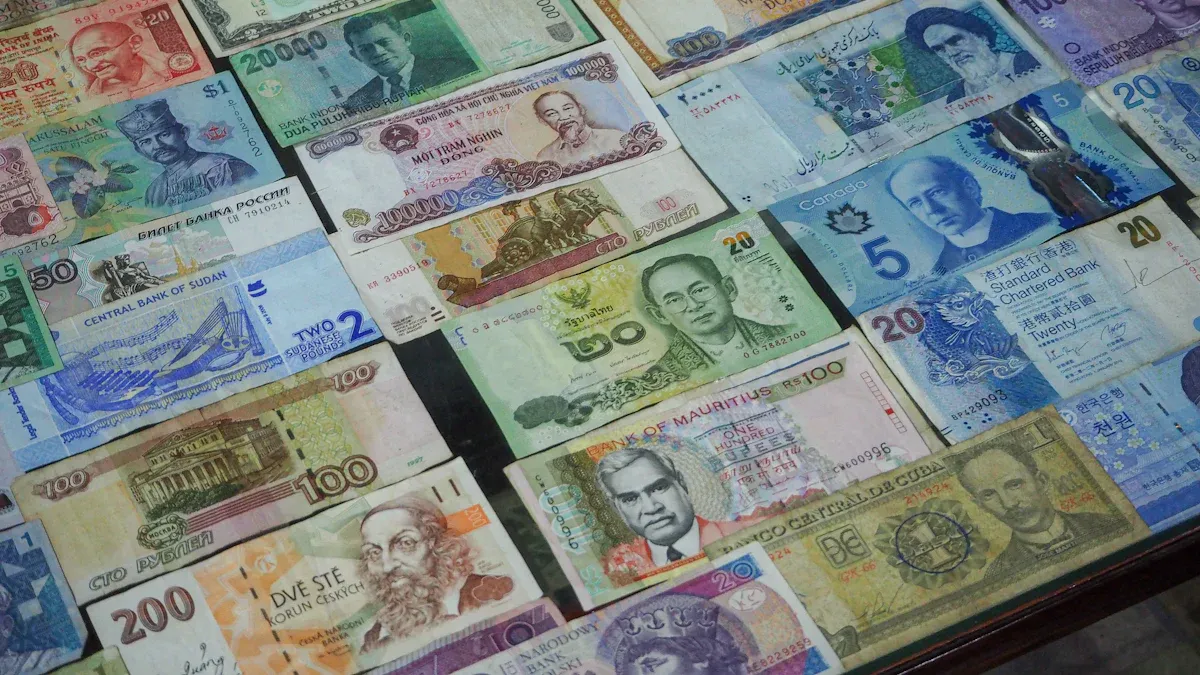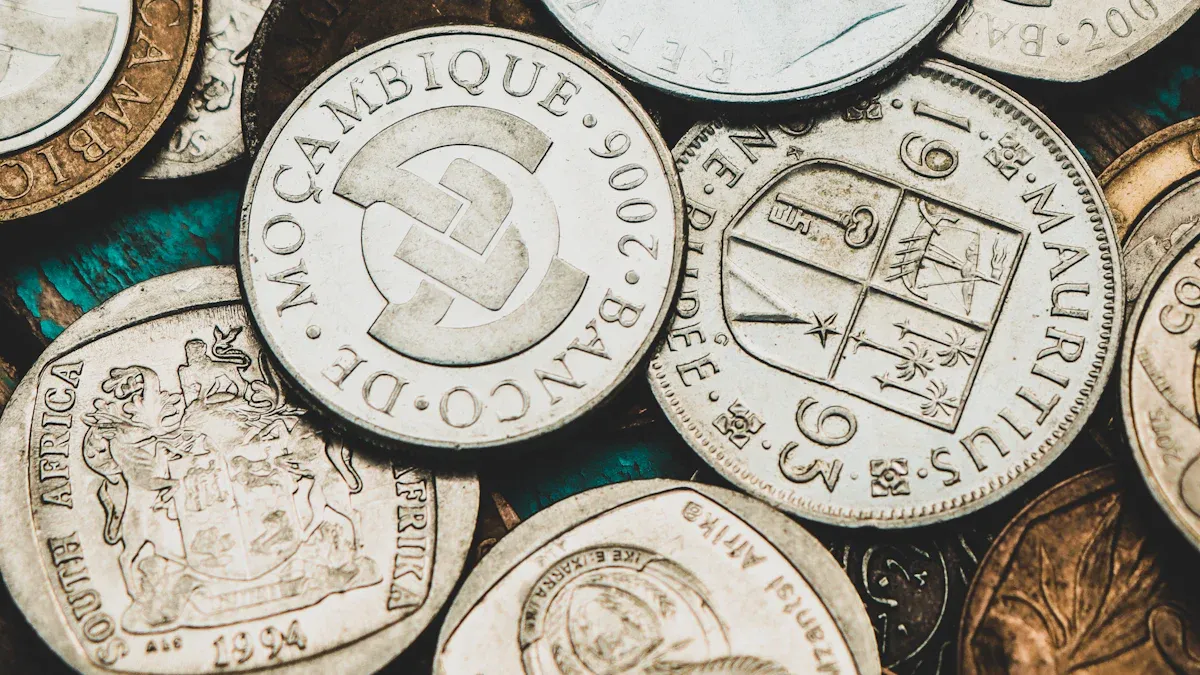- EasyCard
- Trade
- Help
- Announcement
- Academy
- SWIFT Code
- Iban Number
- Referral
- Customer Service
- Blog
- Creator
How to Use the Uruguayan Currency? Analysis of Currency Exchange, Remittance, and Related Regulations

Image Source: pexels
Uruguay’s official currency is the Uruguayan Peso (UYU). You can easily obtain cash at city center exchange offices (Cambio) or ATMs. Although USD is also accepted in tourist areas and large businesses, using pesos is generally more cost-effective for daily small transactions.
Key Tip: Planning your Uruguayan currency strategy in advance can make your financial arrangements much smoother.
Key Points
- The Uruguayan Peso is the official local currency, but USD is popular in tourist areas.
- Exchange offices and banks offer peso exchange services, and ATMs are convenient for cash withdrawals.
- Using international credit cards allows you to automatically enjoy VAT refund benefits.
- Remitting to Uruguay requires the recipient’s full name, address, and 8-digit ID number.
- Carrying cash exceeding $10,000 when entering or leaving the country must be declared to customs.
How to Exchange Uruguayan Pesos (UYU)?

Image Source: pexels
Successfully exchanging Uruguayan Pesos is a critical first step for your trip. Knowing where and how to exchange can save you money and avoid unnecessary hassle. This guide will detail the best exchange strategies.
Best Exchange Locations
Choosing the right exchange location directly impacts the value of your USD. Below is a comparative analysis of the main exchange channels:
- Exchange Offices (Cambios) You can find many exchange offices in city centers like Montevideo, which are often the best choice for obtaining pesos. These institutions are highly competitive, so they offer relatively favorable rates. For example, exchange offices like Aspen strive to provide the best market rates for customers.
- Banks (Bancos) Uruguayan banks, such as Banco República (BROU), sometimes offer exchange rates closer to the mid-market rate than exchange offices. Tests show that exchanging $250 at a bank may yield over 200 pesos more than at some exchange offices. However, banks have limited hours and may require queuing.
- ATMs (Cajeros Automáticos) ATMs are widely available in Uruguay’s cities and towns, making them a convenient way to get cash. When withdrawing with an international card, many local banks (e.g., BROU and Itaú) may not charge additional fees, though your issuing bank might.
Important Note: Always avoid independent ATMs at airports, hotels, supermarkets, or bus stations. Airport exchange counters typically offer the worst rates due to limited options. ATMs at supermarkets and bus stations may charge high per-transaction fees of $8 to $12.
Key Bank ATM Withdrawal Information Reference
| Bank Name | Per-Transaction Limit (UYU) | Local Bank Fees | Recommendation |
|---|---|---|---|
| Banco República (BROU) | 20,000 - 30,000 | Usually none | Good rates, recommended to use ATMs inside branches |
| Itaú Uruguay | 30,000 | Usually none | Well-maintained machines, stable network |
| Banco Santander | 20,000 | Usually none | Widely available, convenient to use |
Practical Exchange Tips
Mastering some exchange tips can make your Uruguayan currency experience smoother and safer.
- Bring Crisp USD Cash Uruguayan exchange offices are very particular about the condition of banknotes. Always bring crisp, unmarked USD cash, as old or damaged bills are likely to be rejected.
- Shop Around, Beware of Traps Before exchanging, compare rates at multiple exchange offices. Be especially cautious of services claiming “zero fees,” as they often compensate with worse exchange rates.
- Exchange in Batches for Safety Avoid exchanging large amounts of cash at once. This reduces the risk of carrying too much cash and allows flexibility to exchange as needed, preventing leftover pesos when leaving. Uruguay has no foreign exchange controls, so there are no legal limits on exchange amounts, but exchanging in batches is safer.
- Learn to Identify Genuine Banknotes Familiarizing yourself with the anti-counterfeiting features of Uruguayan Pesos is crucial. Examples for common denominations:
- 100 Peso Note:
- Watermark: Features a portrait and the number “100.”
- Security Thread: A metallic thread with “Uruguay” printed on it.
- Latent Image: Tilting the note reveals a large “100” within the Uruguay map.
- 1,000 Peso Note:
- Hologram: Contains the Uruguay coat of arms and “BCU 1000.”
- Color-Shifting Ink: Tilting the note changes the “1000” in the map from green to gold.
- Tactile Marks: Raised marks on both sides for visually impaired users.
- 100 Peso Note:
Online Exchange Rate Tools
Before exchanging currency, you can use online tools to check current exchange rates to assess whether a deal is worthwhile.
You can use Xe.com or similar apps to check the real-time exchange rate for USD to UYU. This provides an important reference benchmark.
Keep in mind that these tools show the “mid-market rate,” the wholesale rate used between banks and large institutions, which individual consumers cannot access. Your final exchange rate will fluctuate around this rate.
The purpose of these tools is to help you evaluate whether the “buying rate” offered by exchange offices or banks is reasonable. If their quote deviates significantly from the mid-market rate, consider switching to another provider. Doing your homework in advance is the first step to ensuring a cost-effective Uruguayan currency strategy.
Using Uruguayan Currency: Daily Payment Guide

Image Source: unsplash
Mastering how to make daily payments in Uruguay is key to ensuring a smooth trip. Knowing when to use cash and when to use cards can help you maximize your budget and take advantage of local spending benefits. This guide will outline the best daily payment strategies.
Cash Payment Strategies
While electronic payments are prevalent in Uruguay, cash still plays an indispensable role in your pocket. In certain scenarios, Uruguayan Pesos (UYU) cash is the only or best payment option.
- Small Transactions: For buying street food, taking buses, shopping at local markets, or small family-run stores, cash is preferred. Many small merchants lack card payment facilities.
- Tipping: Paying tips in cash at restaurants or for services is a convenient and common practice.
- Emergency Backup: A small amount of cash can serve as a backup payment method when cards are unusable or networks are down.
Practical Tip: Keep some small-denomination notes, such as 100 or 200 pesos. Using large notes (e.g., 1,000 or 2,000 pesos) for small payments may make it difficult for merchants to provide change.
Advantages of Card Payments
Uruguay is a “credit card society,” with over 46% of transactions made via cards. For tourists, using international cards is not only convenient but also offers tangible benefits.
- Wide Acceptance In Uruguay, especially in urban areas, hotels, large supermarkets, chain restaurants, and car rental companies widely accept international credit cards. Data shows Visa is one of the most popular credit cards in the country, with Mastercard also highly accepted. You can confidently use your card in these places.
- Automatic VAT (IVA) Refund This is the biggest advantage of using international cards in Uruguay. When you use a non-Uruguay-issued credit or debit card to pay for specific services, the government automatically waives the Value Added Tax (IVA). This discount is reflected directly on your bill.
Services Eligible for VAT RefundService Category VAT (IVA) Rate Tourist Refund Dining Services (Restaurants, Bars) 22% Full refund Car Rental (Without Driver) 22% Full refund Accommodation (Hotels) 10% Tax-exempt
Important Note: This benefit is applied automatically; no application is needed. Simply pay with your international card at checkout. Before departure, notify your issuing bank (e.g., your Hong Kong bank) of your travel plans to prevent your card from being frozen due to fraud detection.
- Safety and Convenience For large purchases, cards are safer than carrying large amounts of cash. They also eliminate the hassle of frequent currency exchanges, making your Uruguayan currency experience more seamless.
Mobile Payment Status
If you’re accustomed to using mobile payments in daily life, you’ll need to adjust your habits in Uruguay.
Currently, NFC-based international mobile payment methods like Apple Pay or Google Pay are not widely adopted in Uruguay, and most merchants do not support these payments.
While Uruguay has local mobile payment apps (e.g., Mercado Pago), they typically require a local bank account and Uruguayan ID number to register, making them impractical for short-term visitors.
Thus, when planning your Uruguayan currency strategy, the most reliable combination is: cash for small payments and international credit cards for large purchases.
How to Handle International Remittances?
Whether you need to support family in Uruguay or process business payments, understanding how to remit internationally efficiently and cost-effectively is crucial. Choosing the right remittance channel can save you significant time and money.
Comparison of International Remittance Channels
Different remittance methods vary in speed, fees, and exchange rates. You need to choose based on your specific needs.
| Remittance Method | Advantages | Disadvantages |
|---|---|---|
| Bank Wire Transfer | Traditional, secure, suitable for large transfers. | Slow (typically 3-5 business days), high fees, poor exchange rates. |
| Western Union | Very fast, recipients can conveniently collect cash at global locations. | Expensive fees, exchange rates often much worse than market rates. |
| Wise (and other online platforms) | Uses real mid-market rates, transparent fees, convenient operation. | Requires recipient to have a bank account, unsuitable for cash-only transactions. |
Special Recommendation: Wise Wise is a highly popular online remittance platform. Its biggest advantage is using real-time mid-market rates without hidden markups and supporting direct remittances from CNY to UYU, offering great convenience for users from mainland China.
Key Remittance Information and Process
The remittance process to Uruguay is straightforward, but you must have accurate recipient information. Missing or incorrect details are the most common reasons for remittance failures.
Before remitting, confirm the following three key pieces of information with the recipient:
- Recipient’s Full Name (Nombre completo): Must match the name on their ID exactly.
- Recipient’s Address (Dirección): Complete residential address.
- 8-Digit Uruguayan ID Number (Cédula de Identidad): This is the most critical information, required by nearly all remittance channels.
Important Note: Without an accurate 8-digit ID number, your remittance cannot be completed. Double-check this number before initiating the transfer.
The remittance process typically involves entering this information on your chosen platform (e.g., Wise or your bank) and making the payment. Fee structures vary by channel but usually include a fixed fee and a percentage-based currency conversion fee. Before final confirmation, the platform will display all fees and the final amount received.
What Currency Regulations Must Be Followed?
To ensure your financial activities are legal and compliant, understanding and adhering to Uruguay’s currency regulations is essential. These rules are not complex, but knowing them in advance can help you avoid unnecessary trouble and make your trip smoother.
Cash Entry and Exit Declarations
Uruguay has clear legal requirements for carrying cash across its borders. If you plan to carry large amounts of cash, you must comply with declaration rules.
Key details of this regulation:
- Total Amount Calculation: The $10,000 limit refers to the total cash carried by you or your traveling group, not per person.
- Currency Types: The rule applies to all currencies, including USD, EUR, CNY, etc., covering any circulating banknotes and coins.
Failure to declare can lead to serious consequences, including cash confiscation and fines. If you carry amounts close to or exceeding this limit, complete a declaration form at the customs office upon arrival or departure.
Large Transaction Restrictions
To prevent money laundering and other illegal activities, the Uruguayan government regulates large cash transactions. While this primarily affects residents, tourists may also encounter it in some cases.
When attempting large single cash transactions at exchange offices (Cambio) or banks, such as exchanging thousands of USD, staff are likely to request identification, typically your passport, and record your details.
This reinforces the earlier advice: for large purchases, using an international credit card is wiser. It not only allows you to enjoy automatic VAT refunds but also avoids the risks and inconvenience of carrying large amounts of cash, making it a safer and more efficient way to use Uruguayan currency.
To make your financial activities in Uruguay smoother, keep these core tips in mind:
- Daily Expenses: Exchange USD for pesos at city exchange offices (Cambios) for small expenses like transportation and tips.
- Large Purchases: Prioritize international credit cards for dining and car rentals. Your card issuer will automatically apply VAT (IVA) discounts to your bill based on receipts.
- International Remittances: Consider using online platforms like Wise. They typically use mid-market rates without hidden markups, making them more cost-effective than traditional banks.
- Cash Declarations: Declare cash exceeding $10,000 when entering or leaving the country.
Planning ahead and understanding these rules will make your Uruguay trip financially easier, safer, and more cost-effective.
FAQ
What currency should I bring to Uruguay?
You should bring crisp USD cash. Uruguayan exchange offices widely accept USD but are strict about note condition. Damaged or marked bills may be rejected.
Can I use international credit cards in Uruguay?
You can widely use international credit cards in Uruguay. Hotels, restaurants, and large stores generally accept them. Using non-Uruguay-issued cards also grants automatic VAT refund benefits.
Can I use mobile payments like Apple Pay?
You generally cannot use international mobile payments. Apple Pay or Google Pay are not widely adopted in Uruguay. Cash and credit cards are recommended as primary payment methods.
How do I handle leftover pesos when leaving?
You can exchange pesos back to USD at exchange offices (Cambio), but rates are often unfavorable. The best strategy is to exchange in batches to avoid having excess cash when leaving.
*This article is provided for general information purposes and does not constitute legal, tax or other professional advice from BiyaPay or its subsidiaries and its affiliates, and it is not intended as a substitute for obtaining advice from a financial advisor or any other professional.
We make no representations, warranties or warranties, express or implied, as to the accuracy, completeness or timeliness of the contents of this publication.




Contact Us
Company and Team
BiyaPay Products
Customer Services
is a broker-dealer registered with the U.S. Securities and Exchange Commission (SEC) (No.: 802-127417), member of the Financial Industry Regulatory Authority (FINRA) (CRD: 325027), member of the Securities Investor Protection Corporation (SIPC), and regulated by FINRA and SEC.
registered with the US Financial Crimes Enforcement Network (FinCEN), as a Money Services Business (MSB), registration number: 31000218637349, and regulated by FinCEN.
registered as Financial Service Provider (FSP number: FSP1007221) in New Zealand, and is a member of the Financial Dispute Resolution Scheme, a New Zealand independent dispute resolution service provider.



















